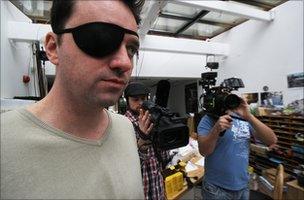Canadian film-maker's bionic eye
- Published
Rob Spence shows how his camera eye works
Canadian documentary maker Rob Spence has always loved science fiction.
So much so that when he lost his eye six years ago, he took inspiration from some of his heroes.
"There are so many characters in pop culture and science fiction that have a camera eye that pretty much anyone who loses an eye at least makes a joke about getting a camera eye.
"In my case, I just actually did it."
With the help of a former satellite company employee, he developed a camera which fits into his eye socket, and "eyeborg", as he calls himself, was born.
Shooting accident
The original damage to his right eye came from an accident when he was just nine years old.
"I was visiting my grandfather in Northern Ireland and I decided it would be a good idea to take his 12-gauge shotgun and go and shoot some cowpats.
"I wasn't holding the gun properly and it caused a lot of trauma to my eye."
The deterioration was gradual, with years passing before all vision was lost in the eye. When it was lost, surgeons recommended its removal to prevent any deterioration in the other eye.
Spence has felt no great loss of ability, perhaps because the deterioration was so gradual. Nor was his quest for a camera eye motivated by any hope of improving his sight, he says.

Spence says he can achieve more natural results with his eye camera than with conventional cameras
"The motivation to put a camera in there was a combination of being an immature adult who wants to be like Star Trek or the Bionic Man, and an opportunity to make more interesting documentary films that a have a more literal point of view."
The camera was built by friend and engineer Kosta Grammatis, external, who used to work for satellite and rocket company SpaceX. They got on so well that he moved in with Spence, and the first prototype eye was built on a coffee table.
The eye is currently in its third incarnation, and transmits live video pictures to a wireless monitor.
It attaches to a coral ball and coupling device which was fitted into the socket after his natural eye was removed (for the purpose of an aesthetic eye). This means it moves in tandem with his remaining eye and that Spence can direct the camera to its target.
It has become a fundamental part of his documentary making.
"When I'm filming someone, they're looking right in my eye and they're talking to me, not me through a camera, and there's blinking and glancing. It's much more similar to the way we see the world."
Bionic journey
His latest film is a 12-minute documentary, external pegged to the launch of Deus Ex: Human Revolution, a video game which features a bionic human with their own camera eye.
For Spence, it was a chance to explore some of the innovations in bionics that are happening around the world, and to meet some of the people testing them.
This included interviewing Miikka Terho, a Finnish man with an inherited form of blindness who has been testing an eye implant which has enabled him to pick out large shapes and lights.
Spence thinks the future of bionic vision will be played out in high definition.
"I liken bionic eye technology - that is the sight-restoration kind, not my kind - to very early television. Just as television progressed from blurry terrible images to something that approximates to human vision, I see that happening as well with sight-restoration technology."
- Published3 November 2010